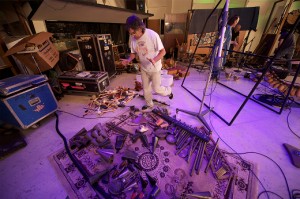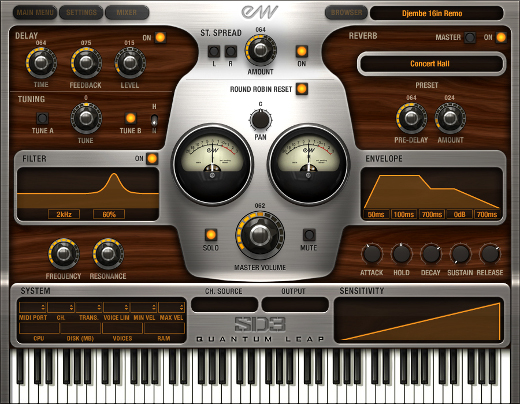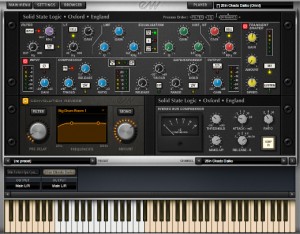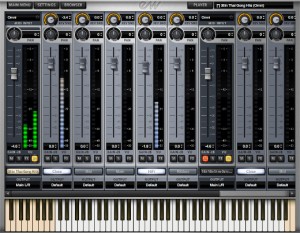Review: Stormdrum 3 Virtual Percussion Instrument — by Carmen Borgia
Many years ago I happened upon a book titled Musical Instruments of The World. It was amazing; thousands of instruments from all over the planet, accompanied by a sentence or two of description and a beautiful little drawing of each.
I spent hours flipping through the pages, soaking in the endless creations that are made to make music. Enough information was given to convey what made each instrument work; enough to even build some of them from scratch. I imagined that I would eventually have all of these instruments to play, touch and be surrounded by. I mean, they all fit so neatly into the book!
I know now that no matter how many instruments I build, buy, barter or adopt that I will never do more than scratch the surface of what can be played. And that doesn’t even include anything digital. Guitars, zithers, ratchets, shakers, spike fiddles, trumpets, kettle drums and bongos, It would be so great to have them all.
So, I feel equal parts curiosity and desire when I hear of an individual who has amassed a great instrument collection. I suspect many successful musicians have large assortments of cool things hiding in their homes, waiting for the song that needs exactly that perfect, unique fit.
But some musicians tell you what’s in their collection by putting it all into their music. I encountered the work of Mickey Hart with the release of two albums, Planet Drum and At The Edge. These albums showed the sonic range of world percussion with beauty, musicality and grace. Hart has had an incredible career as percussionist for the Grateful Dead, the Rhythm Devils and many other projects. He has made scores for films and is a great teacher and advocate for percussion artistry the world over.
EastWest Sounds has now released a collection of samples from Mickey Hart’s extensive collection of drums and percussion instruments as the Stormdrum 3 virtual instrument. Will it re-create his deep collection? Can it offer the nuance and control that a skilled player brings to the band? Porting instruments with so much sonic variation into MIDI-land usually leaves a lot to be desired.
Getting Started
I received the Stormdrum 3 box by mail. It came with 87 Gigabytes of samples stored on eleven DVD’s. It took almost 7 hours to transfer the data to my hard drive. Then I downloaded the latest version of Play, the East West sample player from their Website. Authorization is accomplished via iLok and the authorization process went smoothly.
I initially encountered a couple of technical hangups. The first was that I was hearing clicks and crackles during playback. I increased my playback buffer in Pro Tools 10 and the undesired noises vanished. A second issue I encountered was that once I quit Pro Tools and later re-launched, the samples did not play back unless I re-loaded then manually into Play. After a bit of back and forth with very friendly tech support at EastWest, they provided a revised driver that fixed the bug. Service!
What Stormdrum 3 is Made Of
EastWest offers numerous virtual instruments in addition to Stormdrum, which are accessed through Play. If you have only one EastWest product on your system (as I did for this review) then instantiating Play on an instrument track brings up Stormdrum 3 by default. Each EastWest instrument has a distinctive look that makes it easy to see which instrument you are currently working with.
Stormdrum 3 offers five main windows using buttons along the top of the instrument. A piano keyboard runs along the bottom of each window indicating which keys control samples. Clicking on the front of a key previews the sound at full velocity, transitioning to low velocity as you click to the rear of the key. Super useful.
The browser window allows selection of the virtual instrument and loading of sample sets. If you have multiple EastWest instruments you may load them here. All of the available instruments can be navigated in a multi-column format. Multiple instruments may be loaded within a single browser window for multi-timbral operation.
The Player window hosts commonly used controls. A delay with time, feedback and level controls and a simple but versatile convolution reverb is provided. Master tuning is on the left with the capability to shift the tuning with or without maintaining the tempo in the case of live loops. A filter with frequency and resonance knobs allows the sound to be shaped from subtle to severe. An AHDSR envelope sits above an adjustable keyboard sensitivity curve. An easily read panel of system stats such as RAM use and how many voices are sounding is tucked in the lower left corner.
The center section, which resembles a skull or maybe an alien death-mask, is where stereo spread, round robin reset, solo, mute and master volume controls live. Two vintage-looking circular level meters make the eyes of the skull. Kind of like having company when I’m working, I like it.
The main menu provides an alternate means of loading a voice to the browser. Voices can be saved and saved-as. Voices can be loaded into RAM or streamed from disk. Windows can be navigated and sample management including purge, reset and reload are accessed. There is a Settings button where you can tweak how the samples stream from the drive and a few other under-the-hood adjustments.
The mix window allows adjustment of overall volume, pan, output, mute and solo of each instrument. These parameters cannot be automated as far as I can tell. There are two very nice buttons at the bottom of the fader strip. The first, labeled “FX”, opens a window for the Solid State Logic channel strip, transient shaper and bus compressor plug-in. The EastWest convolution reverb can be accessed here as well. I’ve been using a similar SSL plug-in in my DAW and I love it, it’s great to have a processor that sounds this good included with a virtual instrument. Sometimes processors in this context feel like throwaways, that is not the case here.
The second very nice button has an icon of mixing faders, when pressed it reveals five additional faders for the channel. The samples in this collection were recorded with multiple microphones: Close, Mid, Main, HiFi and Ribbon. Each has volume, pan and another FX button that reveals more SSL channel strips minus the convolution reverb and bus compression. Pretty fun!
IN USE
The challenge here is to replicate the control a percussionist has with a similar collection of real instruments.
Stormdrum 3 approaches this challenge by using a vast number of samples. Each individual instrument has been beautifully recorded and programmed to make the instrument as responsive and intuitive for the player as possible. There isn’t any key switching, the focus is on multiple articulations and velocity layering to achieve tonal variation. Since many of the sampled instruments are not chromatic, variations in playing are spread across the keys.
Carmen Borgia on Stormdrum 3: Large udu drum, deerhoof shaker, waterphone
Don’t look for your standard drum machine layouts with many instruments available on one keyboard, each instrument here seems designed to give you the natural range of sounds that particular instrument can make – quality over quantity. The Brazilian surdo drum, for example, only uses 12 keys for what it does, but the samples occupy 808 MB when loaded into RAM. If you have five mics to choose from, that’s 161.6 MB of audio for each mic.
I’m not sure what kind of encoding is used to make it all work but it sounds wonderful. Play it light and you get a lovely pianissimo, whack the key hard and the you can hear the note bend under the stress and maybe a bit of stick noise. Play it just slightly lighter and the stick noise goes away or sounds a little different. It has lots of layers. A round robin playback scheme rotates different samples when a note is played repeatedly, which eliminates the tommy-gun effect that can occur. I’m not saying I’m ditching my real surdo – yes, I have a surdo – but I laid a Stormdrum 3 track into a demo I was composing and it sounded great. So, it’s like I have two surdos now.
You can tell from sample load times that some instruments have a lot more samples than others. The waterphone loads very quickly, the talking drum takes a bit. This makes sense as some instruments probably don’t lend themselves to velocity layers, the waterphone being a good example. The talking drum, on the other hand, makes the most of nuance available in layering samples. The instrument is responsive and natural, even using a piano keyboard the results are very nice.
When I discovered the mix window and realized that in many cases the instruments had been recorded with five mic/position variations, and that the positions can be blended as needed, I gave a little yelp. It’s the most advanced version of such a thing that I’ve seen, it greatly extends the usefulness of the library. So much depends upon mic placement (a great reason to keep my real surdo) and this feature is very handy when it’s time to mix.
Many of the instruments include samples of musical phrases – such as for rolls or patterns. This is essential for hand drums and shakers that tend to have an established sonic vocabulary. More unusual instruments, such as the Mongolian Chimes, seem to have a bit more of a random selection of sounds. Even so, after having the entire collection in my hands for a few months, there is so much to explore that I feel there is a lot I haven’t taken in. It’s not that there are 5,000 presets, it’s that each sample instrument may have a level of playability that is quite deep.
Also included is a selection of live loops that respond to the tempo setting in your DAW. I would say that these recall the albums mentioned at the beginning of this review. I tend to shy away from store-bought loops out of a fear that they’ll be overused out in the world. But I must say these are well-implemented; very natural at the original tempo but they hold up well when stretched or squashed. At extreme tempos you get the unavoidable artifacts, but that can be useful in the right situation.
The install time would be a drag for some, so East West offers Stormdrum 3 on a USB3 hard drive or DVD. In a related issue, the large quantity of samples means that you will benefit from a pretty zippy computer and drive setup. My Mac Intel tower is a few years old and it held up nicely, but this install filled my instrument drive the rest of the way, so one upgrade may yet lead to another.
Carmen Borgia on Stormdrum 3: Surdo drum – close and ribbon mic
CONCLUSIONS
Would I like to have Mickey Hart’s gigantic selection of real drums to beat, tap and touch? You betcha. The tactile aspects of real instruments are part of what I love about music. But tracking down and maintaining exceptional instruments is no joke, until Mr. Hart invites me to a session to play ukulele (hint, hint) this is as close as I’ll get to that.
And this virtual instrument is very good. It’s probably the most sophisticated sample set of percussion that I’ve used. The tradeoff here is the infinite variation of the real thing versus the convenience of having everything in your DAW.
I began using these sounds on projects right away. I’ll see if these tracks make it all the way to the mix, but they’re significantly better than other virtual percussion things I’ve seen. As a bonus I found that some of the metal and shaker family dropped nicely into a sound design for a documentary I’m working on. These sounds added a nice organic something to dramatic booms and swooshes that help define and pump up the graphics.
I’m very happy to have this set in my collection. I think it’s well worth the price of $395 for DVD install and $479 for a pre-loaded hard drive. If you want natural sounding drums but can’t have them for whatever reason, this is a great thing. If you have the real thing, this might be a good complement to your collection for less than the price of a single fine drum.
Carmen Borgia on Stormdrum 3: Live loop, dark star bells
— Carmen Borgia is a freelance sound designer, mixer and composer. Find him at http://www.carmenborgia.com for all your animated robot audio needs.
A full composition by Carmen Borgia on Stormdrum 3: loops, Cajon, + Carmen on ukulele and guitar
Please note: When you buy products through links on this page, we may earn an affiliate commission.











